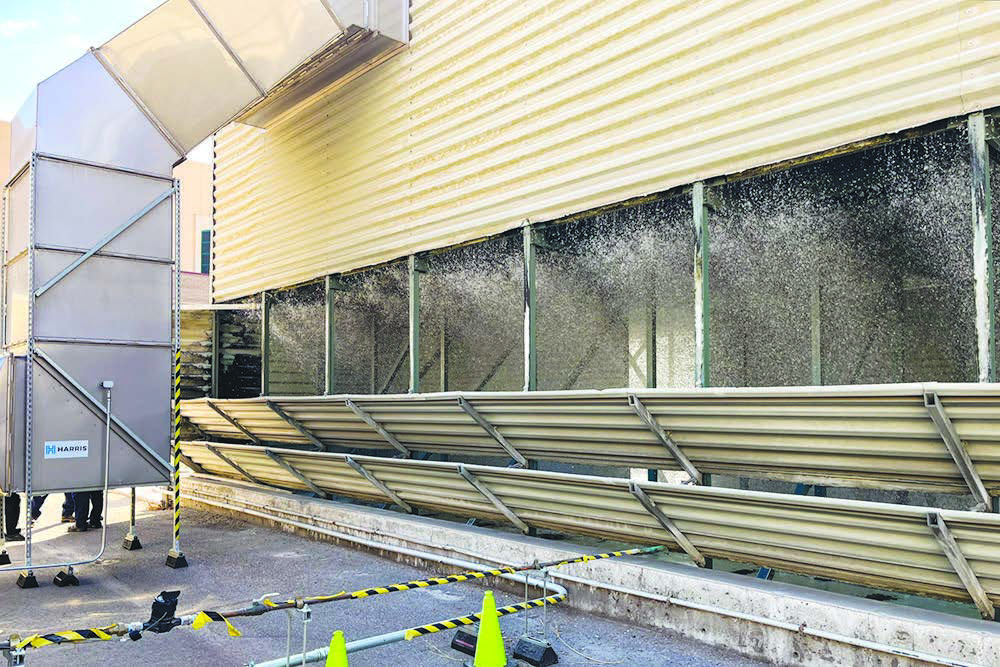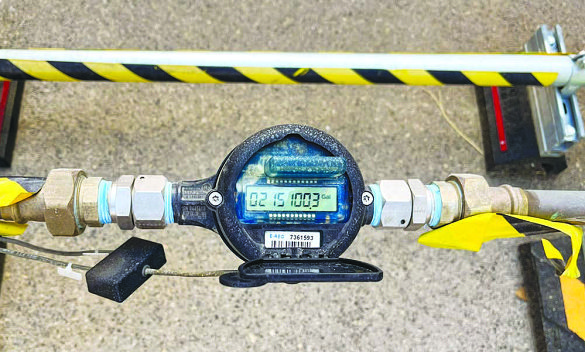
The atmospheric water generator at the MGM Grand was installed in November 2023.It produces up to 1,200 gallons of water a day and has saved over 200,000 gallons of water. Formula One and the Southern Nevada Water Authority partnered on the generator to offset the water used to clean the track for the Las Vegas Grand Prix.

The Las Vegas Grand Prix track was doused with about 30,000 gallons of water to keep the course clean and ready for competition last year during the inaugural installment of the Formula One race.
Not all the water, however, was wasted.
To offset water used on the track, the Southern Nevada Water Authority built an atmospheric water generator attached to an evaporative cooling system at MGM Grand. The generator is believed to be the first of its kind on the Strip, said Bronson Mack, the Southern Nevada Water Authority spokesperson.
The race league’s paddock on Harmon Avenue — the main building and garages for the race — were constructed last year to have dry cooling, which consumes less amounts of water in the HVAC cooling process than evaporative cooling, as part of the race’s sustainability plan, Mack said.
Formula One decided to take it a step further and find a way to offset water use when race workers clean the track.
The total investment for the atmospheric water generator was $400,000, Mack said. The Las Vegas Grand Prix, WaterStart and the water authority covered that investment and MGM Resorts International provided the location and operation at the MGM Grand. “(Formula One) wanted to be the first net-zero water consumption sporting event in Las Vegas,” said Michael Bernardo, the enterprise conservation division manager for the water authority. “When you wash the track to get it prepped for the race cars, that water will evaporate, and when it evaporates and goes into the atmosphere, you lose it.”
The course is again being constructed forthisyear’srace, Nov. 21-23. Athorough cleaning of the track helps ensure the safety of the drivers during the race.
The generator looks like a small portable building with a large vent structure sticking out its front, two windows on the side and hazard symbols on the pipes on the ground.
By using an atmospheric water generator along the evaporative cooling tower, new water is created. The unit has pro duced 200,000 gallons of water, Bernardo said.
“That’s 200,000 gallons less that came out of Lake Mead,” Bernardo said. “We’ve all generated ... more water than anticipated.”
The atmospheric water generator was installed in November 2023 before last year’s race week, Bernardo said. Although the desert Southwest has low humidity, cooling towers create a cooling effect on the HVAC pipes and the water that is discharged is very humid, he said.
To get the atmospheric water generator to work, there is a vent structure that pulls air from a fan connected to it, Mack said.
The fan draws out the air through the vent and fan and into the cooling system to make water. Then the water is added back into the evaporative cooling system.
“Every gallon this unit adds to the evaporative cooler is a gallon of water that MGM doesn’t have to pull out of the water distribution system,” Mack said. “That’s a gallon of water that can be used by someone else.”
WaterStart, a nonprofit group based in Las Vegas, works with companies and drinking water utilities around the world that have similar sustainable challenges, said Rebecca Shanahan, interim executive director at WaterStart. WaterStart looks for technology to find solutions that fit those companies’ and utilities’ operations.
“Without technology, how else would you solve problems?”
Shanahan said. “People need to shift the way they think about water.especially in the Southwest.”
This is WaterStart’s first pilot project that includes an atmospheric water generator. The organization originally was structured around utilities’ needs, Shanahan said.
“This has been a very fulfilling project because everyone that came to the table fully recognized that this might not work but was willing to dive in and give it a try,” Shanahan said. “I look forward to seeing it progress.”
Evaporative cooling is the second-largest water consumptive use in Las Vegas, accounting for 20% of water use consumption for some properties, Mack said.
Cooling units are seen at most every property along the Las Vegas Strip and smaller units at schools, universities and big-box stores.
“Our goal in the future is to ensure that we’re doing anything that we can with the technology in front of us to save water,” Bernardo said.
To know if using atmospheric water generators and cooling systems would work well together at other properties in Las Vegas, Bernardo and the team need to plan on when the unit works most efficiently, he said.
For instance, from the beginning of December to the beginning of April, the cooling tower turns off because it’s cooler.
They also would like to explore whether a cooling system can support the weight of the atmospheric water generator on top of the unit, how it performs in different weather conditions and how renewable energy could offset electrical use.
“If this technology proves to work (it) can showcase and build our opportunities for businesses like Formula One (or) MGM,” Shanahan said. “(They) can utilize this technology, learn from it and emulate the initiative here and think about reducing their water consumption.”

